The amount and variety of eyewear at Vision Expo East can be difficult to process at times. It sometimes appears that every conceivable concept or application for a pair of frames is on display somewhere within the Jacob Javits Centre for the duration of the New York show. However, year after year new start-ups and innovative designers come up with fresh products to keep the market moving.
Of course eyewear does not only exist in the mercantile environment of a trade show. It really comes to life when worn; put the right frames on the right person and a bond lasting decades can be formed. So it is interesting to compare and contrast three eyewear companies at last month’s Vision Expo East, in different stages of development, grown out of optical practices and a desire to better serve wearers.
Talk to Garrett Leight, founder and creative director of Garrett Leight Optical, for a few minutes and it is clear he has exceptional understanding of not only the dynamics of fashion eyewear but also the minute nuance of manufacturing processes and materials. There is a good reason for this impressive grasp of the eyewear business.
‘My father founded Oliver Peoples in 1986 so I was born into the industry,’ says Leight. ‘I was there for a couple of years learning the trade but I wanted to do my own thing. In 2009 I opened my first store on Abbot Kinney Street near where I lived in Venice Beach, Los Angeles, at a time when it was up and coming as a destination for shopping and that really set things off. My customers were really cool and interesting and they were buying certain vintage frames. They inspired me to start designing my first collection.’
The brand is built around Southern California and specifically Los Angeles and Venice Beach, which Leight says has been an incredible community for decades with artists like Ed Ruscha and bands including the Doors.
‘We launched in 2011 and I went on the road with a sales kit and opened all the first accounts myself,’ says Leight. ‘The collection itself is classic but has evolved over the years. We definitely focus on fit and a classic retro inspiration but recent collections have seen us introduce more transgender styles, more feminine styles, more colour and lots of sun clips to broaden the customer base. At first it was a small tight collection that focused on good selling classics. Now we take a little more risk with shapes and styles.’

Garrett Leight Optical's Clare V design
As an example of the early collections that has stood the test of time Leight highlights Hampton, a classic P3 shape, saying many of the early designs were in this vein.
‘We update with different sizes and colours for bestsellers,’ says Leight. ‘So Hampton now comes in three sizes and we will do a metal clip and an acetate clip. All of our clips fold. Functionality is very important to me, as a male designer I know guys don’t want to carry lots of stuff around.’

Garrett Leight Optical's Linnie model
Another stalwart of the collection is the Wilson, which Leight describes as ‘one of the trendy styles that gets the most press coverage’. From the most recent collection Linnie, a rounded optical aviator with reverse Windsor rims and metal/acetate temples, is a personal favourite while the Clare V sunglass is the fruit of a recent collaboration with Los Angeles accessories designer Clare Vivier.

Garrett Leight Optical's Wilson design
‘This is definitely having a hot moment,’ says Leight. ‘It’s a French inspired 1970s cat’s eye. This has been everywhere.’
The various frames in the collection are linked by certain core properties: custom made five-barrelled hinges with one side gold and one side silver, names drawn from streets in the Venice Beach district of Los Angeles and the area zip code – 90291 – etched into them by laser.
‘There’s a lot of attention to detail on the frames and the stores,’ says Leight. ‘I’m really proud of what we are doing.’
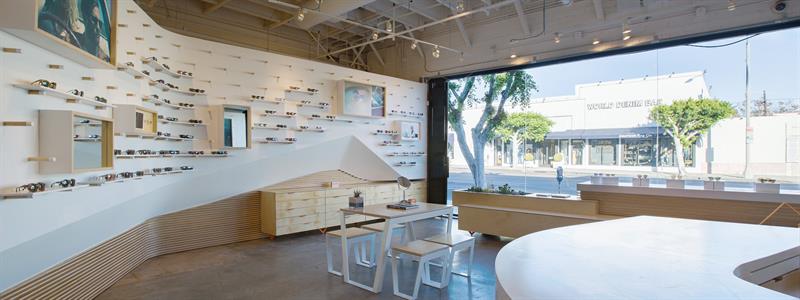
The Garrett Leight Optical store in La Brea
Just as Garrett Leight Optical is inspired by Los Angeles, Silver Linings has New York City in its DNA. A highly esteemed optical practice in SoHo, Manhattan, specialising in vintage eyewear, Silver Linings launched its debut collection in the autumn of last year.

The Silver Linings store
‘Our store has been around for a decade and we are really parlaying our expertise and our clientele’s input of what they like and don’t like into a collection that is affordable and accessible,’ says Jordan Silver, co-owner of Silver Linings Opticians. ‘Some of the vintage frames we love most are hard to find and cost thousands of dollars.’
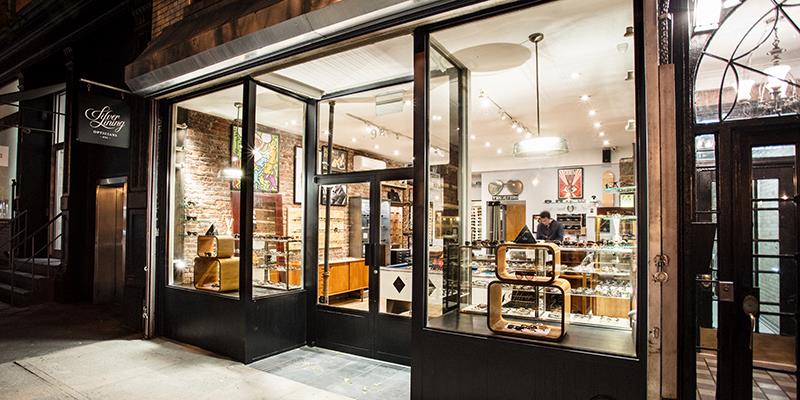
The exterior of the Silver Linings store
The company started with a 12-piece collection and for its first Vision Expo East added six more.
‘We do acetates and titanium designs inspired by New York City,’ says Silver. ‘Our frames have glass lenses and feature lots of elements that pay homage to the vintage sunglasses that our practice is known for, such as really thick highly bevelled edges. Our design language incorporates a hexagon and a rivet in all of our frames. We don’t use anything smaller than a five barrelled hinge.

The M21 model
‘Our frames are very architectural, as you would expect of frames inspired by New York City, and invoke 20th century art deco rather than 19th century art noveau.’
All the frames are named after New York City bus routes as Silver wanted a naming system that was systematic and part of the city.
Asked to pick a favourite among the new designs, Silver says he is ‘really excited about M12 in gold and black – it’s my favourite.’

The M12 model
Opticianado is an independent optical practice in Toronto, Canada, owned and run by vintage frame devotee Jordan Paul. Having spent years building an extensive collection of vintage eyewear and sunglasses from the 1950s to the early 1990s, Paul identified a gap in the market for larger vintage styled designs.
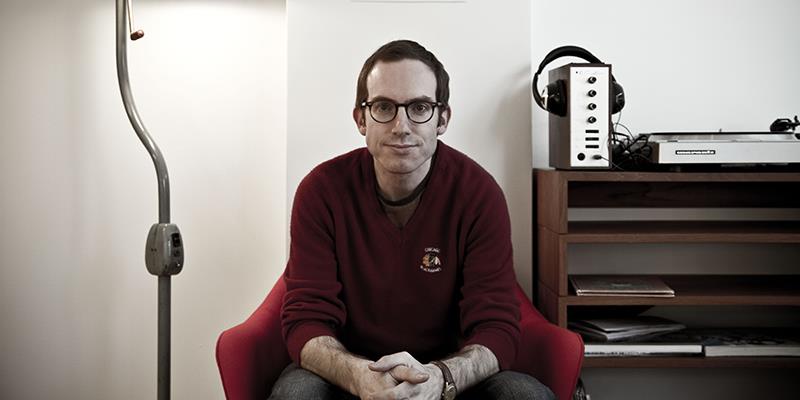
Opticianado’s Jordan Paul, is a fan of vintage-styled design
‘I consistently found that larger vintage or vintage style frames are very hard to come by,’ says Paul. ‘A lot of companies will make frames that fit only 60 to 70% of the population. I’ve been an optician for 20 years and this is biggest gap in the market that I’ve seen.’
With that in mind Paul set out to create high quality vintage inspired frames that could fit larger faces.
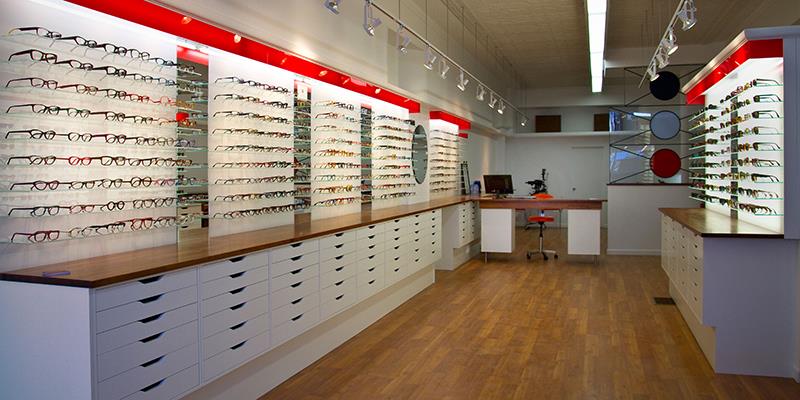
The Opticianado store
‘The first model, Opticianado 101, we made had a panto or P3 shape,’ says Paul. ‘People with a larger head generally have a larger bridge, so suit this frame as it is very specialised with the fit and angle of the bridge.’
For construction Paul’s thoughts turned immediately to Italy and he was able to find a factory that had made many of the vintage frames he most admired.
‘My designs are all handmade in Segusino, Italy, with Mazzuccheli acetate,’ says Paul. ‘The factory I use is a family business that has been producing beautiful eyewear since 1970 – vintage Pierre Cardins, for example. I’ve carried some of its brands in my store. I went over to Italy to deal with the owner directly. The business is quite low key but the manufacturing is flawless; I was really impressed by that.’
The brand is divided into the core Opticianado collection and the Macro collection, with the latter offering designs for people with particularly high PDs.
‘The core Opticianado Line was designed by an optician – me – for opticians who need frames with well-thought-out, timeless, wearable shapes. After fitting and dispensing eyewear for 20 years, you get to know what shapes will work on most faces, in terms of fit and comfort. The line is a culmination of my experience as an optician.
‘The Macro Collection is designed to fit clients who don’t fit the limits of the industry standard sizes and shapes. A lot of these frames won’t fit everyone and that is because I’m specialising in custom fits that aren’t being addressed by other manufacturers. It’s so gratifying to be able to produce a frame that fits these neglected clients and it’s really useful to have that feedback so I can pass it on to other opticians who are interested in adopting the Macro Collection.’
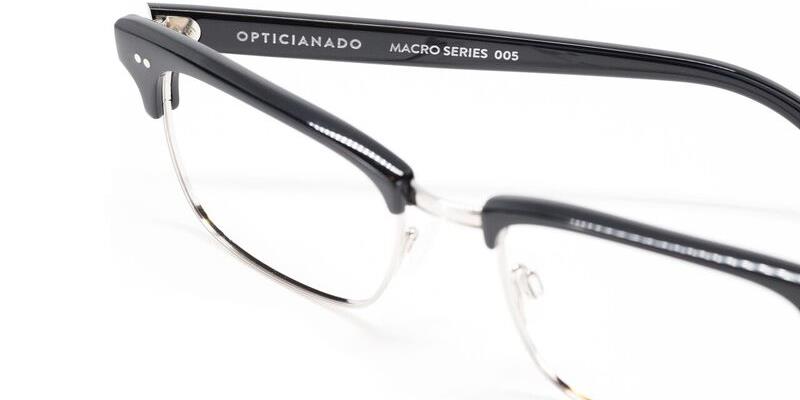
The Macro 005
Paul says that his strong relationships with clients help him as a designer.
’I get feedback directly from my clients. I’m also influenced by the face shapes and sizes of the customers who come in the store. Toronto is the most diverse city in the world, so I have the priceless benefit of seeing the greatest possible variety of faces.’

The Macro 002
The Opticianado store is in a district called the Junction in the west end of Toronto. Like many traditional working class neighbourhoods in global cities, it has been drawing a lot of innovative, young, independent business owners and designers as its undergone gentrification in the past few years.

The Macro 003
‘Opticianado was one of the first businesses to arrive as part of this new wave and the neighbourhood’s independent vibe is a cornerstone of our business,’ says Paul. ‘As a result, we have the most unique stock in Toronto. People come to us to find something different because we have a very extensive collection of deadstock [unworn] vintage eyewear as well as designers that aren’t easily sourced. There’s a great sense of community within the Junction and we host monthly live music in the store featuring some of the great musicians in Toronto. I think it’s safe to say that we’re the only optician with an in-store Hammond B3 organ.’
